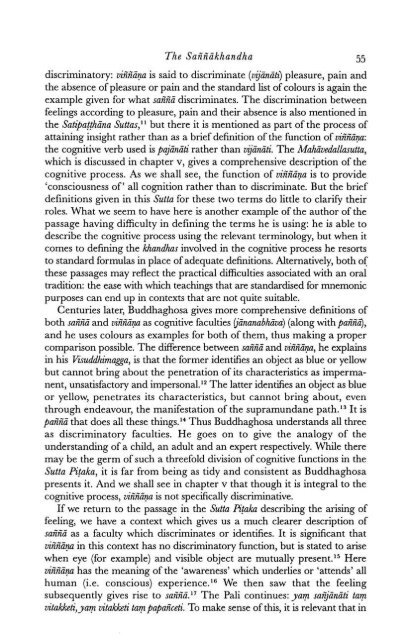Identity and Experience_Hamilton_1996
Identity and Experience_Hamilton_1996
Identity and Experience_Hamilton_1996
Create successful ePaper yourself
Turn your PDF publications into a flip-book with our unique Google optimized e-Paper software.
The San"n"ikh<strong>and</strong>ha 55<br />
discriminatory: vin"n"ina is said to discriminate (veinitz) pleasure, pain <strong>and</strong><br />
the absence of pleasure or pain <strong>and</strong> the st<strong>and</strong>ard list of colours is again the<br />
example given for what san"n"i discriminates. The discrimination between<br />
feelings according to pleasure, pain <strong>and</strong> their absence is also mentioned in<br />
the Satipafihina Suttas,ll but there it is mentioned as part of the process of<br />
attaining insight rather than as a brief definition of the function of uin"n"i?:<br />
the cognitive verb used is pajlniti rather than @iniiti. The Mahivedallasutta,<br />
which is discussed in chapter v, gives a comprehensive description of the<br />
cognitive process. As we shall see, the function of vin"n"ina is to provide<br />
'consciousness of' all cognition rather than to discriminate. But the brief<br />
definitions given in this Sutta for these two terms do little to clarify their<br />
roles. What we seem to have here is another example of the author of the<br />
passage having difficulty in defining the terms he is using: he is able to<br />
describe the cognitive process using the relevant terminology, but when it<br />
comes to defining the Wl<strong>and</strong>has involved in the cognitive process he resorts<br />
to st<strong>and</strong>ard formulas in place of adequate definitions. Alternatively, both of<br />
these passages may reflect the practical difficulties associated with an oral<br />
tradition: the ease with which teachings that are st<strong>and</strong>ardised for mnemonic<br />
purposes can end up in contexts that are not quite suitable.<br />
Centuries later, Buddhaghosa gives more comprehensive definitions of<br />
both san"n"6 <strong>and</strong> vin"ii@a as cognitive faculties (jlZnanabhiva)(along with pan"ii9,<br />
<strong>and</strong> he uses colours as examples for both of them, thus making a proper<br />
comparison possible. The difference between san"n"i <strong>and</strong> vin"n"Zna, he explains<br />
in his Visuddhimagga, is that the former identifies an object as blue or yellow<br />
but cannot bring about the penetration of its characteristics as impermanent,<br />
unsatisfactory <strong>and</strong> impersonal.12 The latter identifies an object as blue<br />
or yellow, penetrates its characteristics, but cannot bring about, even<br />
through endeavour, the manifestation of the supramundane path.13 It is<br />
pan"n"i that does all these things.14 Thus Buddhaghosa underst<strong>and</strong>s all three<br />
as discriminatory faculties. He goes on to give the analogy of the<br />
underst<strong>and</strong>ing of a child, an adult <strong>and</strong> an expert respectively. While there<br />
may be the germ of such a threefold division of cognitive functions in the<br />
Sutta Pitaka, it is far from being as tidy <strong>and</strong> consistent as Buddhaghosa<br />
presents it. And we shall see in chapter v that though it is integral to the<br />
cognitive process, vin"n"ina is not specifically discriminative.<br />
If we return to the passage in the Sutta Piiaka describing the arising of<br />
feeling, we have a context which gives us a much clearer description of<br />
saEEi as a faculty which discriminates or identifies. It is significant that<br />
vin"n"ipz in this context has no discriminatory function, but is stated to arise<br />
when eye (for example) <strong>and</strong> visible object are mutually present.'= Here<br />
uin"n"ipz has the meaning of the 'awareness' which underlies or 'attends' all<br />
human (i.e. conscious) experience.16 We then saw that the feeling<br />
subsequently gives rise to sarln"i.17 The Pali continues: yam sa@initi tam<br />
vitaliketi, yam uitakketi tampapaEceti. To make sense of this, it is relevant that in


